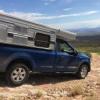Ntsqd, thanks for joining in this conversation. I agree that the “stupid” alternator regulator is an issue. Regarding the CTWK 250s and Smartpass, I looked deeper for more documentation. Here is what I found:
Great writeup on a guy who is very happy with his total Ctek solution for Solar, Alternator and Shore power. - LINK
Ctek discussion at the Expedition Portal, with a recommendation to consider the BlueSea ML-ACR 7622 we already know about
One feature of the 250S I had not noticed before which is really interesting, is that it also functions as a DC-DC converter, and will UP the voltage output of the alternator to compensate for those that are regulated too low (Toyota Tundra comes to mind) or for excessive voltage drop. Very cool.
Here is another DC-DC converter I have seen recommended in the 4x4 community- LINK
I also found this awesome article talking about automotive alternators as “Battery Assassins” - LINK He is talking about boating applications, but those are very similar to what we are doing in our FWC/ATC/Campers. The same fellow also makes alternators ( LINK ) without regulators so you can use the external Balmar style regulators that ntsqd mentioned - LINK
And to clarify how the Smartpass works, and at the risk of being wrong, it does not appear to be 120AC driven. Instead, it bypasses the 250S during the bulk charging stage, and hands control back to the 250S when it detects that the charging current is dropping back to the levels the 250S can handle. That‘s 20A. Remember that number for a bit later....
And thanks to Zirdu, yeah, that pump usage was likely overstated... guess I was dreaming of long & hot showers ;-)... and yes, I am thinking cloudy/rainy days, something the folks in the PNW get too. When I was car camping this summer at Mt Rainier, I saw that most of the campsites had no sun... wonderful shade dappled campsites. So without a long portable cable and room to put the panels on the road (!) or other sunny spot, charging wasn’t happening without a drive. No generators were allowed.
And for sure, if we are only sizing our systems assuming NO days without charging, then it all gets much smaller/cheaper.
I am also starting to wonder if simply upgrading the wiring from the alternator to the camper batteries is just asking to blow my alternator by getting it way to hot. I suspect my alternator/ECU in the truck will protect it from overheating, but don’t know about that. Beware.
And if you need more “backstory” to why all this research and solution finding is necessary, this 2014 thread started by Ethergore is talking exactly about the problems we are uncovering and documenting here - LINK
Plus that thread has a reference to these really nice 300AH batteries that member DesertDave is using If you want to know why we are working so hard on protecting our investment, check the price on these bad boys... and you would need two of them..... GULP!
Speaking of smaller/cheaper, everything I am bringing forward so far seems to be leading towards spending more money and increasing the weight and complexity of the systems. I dislike this!
How to do it right, and do it economically are my questions now.
I for one am unlikely to buy a new alternator and external regulator. So I am stuck with the factory GMC alternator. Luckily, I get 15v+ out of mine. I understand the Tundra folks (post #14 from this thread says 13.5v) are not as lucky LINK & LINK
First,
Reduce how much power you need. Most of us are already doing LED lights, and the newer DC fridges are getting quite efficient.
Second,
Measure you power usage and battery health. Get that Trimetric TM2030!
Third,
Reduce the number of days between no – charging. Weather is unpredictable, but do what you can. Shore power/generator/driving can usually get your batteries up to 85%.
Fourth,
Figure out the “more power” option you are most likely to use. Will you drive every two days? Get sunlight? Get back home for a long time so the 120v is available for several days, ever via shore power or generator?
Fifth,
If you plan on driving every few days, maximize your charging potential. Consider getting the CTEK D205S and SmartPass, and upgrade to BIG wires. The CTEK will up your alternator output voltage (Tundra owners take note), and the SmartPass will dump up to 80A across those big wires. It MAY even compensate for the voltage drop, but I am not sure how, as it doesn't use a second set of wires for voltage sensing.
AT MINIMUM, if you get the D250S and size your wires for 20A, the D250S will pass your camper batteries a max of 14.4V less the voltage drop over your wires at the D250S maximum 20A of current.
As a reminder, this voltage drop calculator will tell you that you need 4AWG wire to get 14.2v to your expensive AGM camper batteries. 2 AWG makes that 14.27V. Both of those will at least get your batteries above the float level, but sadly, below a full absorb charge level.
BEST CASE, get the SmartPass too, and upgrade your wires to 2/0 as well. Using my alternator at 15.2V output, through the SmartPass over 2/0 wire will deliver 14.95V during the bulk phase to my batteries. In all likelihood, that will get me to 85% battery capacity in less than an hour of driving/idling. Then the D250S will take over and at 20A give me 14.34V for as long as needed at the absorb level. Almost perfect.
I say almost perfect. I LIKE the CTEK because it combines a lot of functionality into one box. I just wish the voltages were adjustable. Because my alternator outputs higher than 14.4V, I could possibly be better off without the CTEK.
How? Since I will be upgrading to 2/0 AWG anyway, I could use the BlueSea ML-ACR 7622 to get 15V+ at 40A+ to my camper batteries. I would have to watch how that works though, because keeping that high a rate of charge going will kill the batteries and/or alternator. Hmmm... less than ideal with the Smartpass, but also maybe better than having to keep an eye on this and cook expensive bits.
Could be a win for the CTEK.
Let’s parse this out a bit more. With the CTEK, I don’t need the 7622 ACR That unit alone is $207 USD. IF I can live with only using 12V solar panels, then I also don’t need to get another charge controller for the solar system. That means not having to buy the Trimetric SC2030 at about $130. Total cost = $427. Cost of the CTEK combination is $470 on Amazon.com.
Simplicity + not perfect = happiness? Dunno.
Sixth,
Get more voltage from your solar panels. The cheapest/best solution for 12V and PWM style controllers seems to be the Trimetric SC2030. Unless you are putting more panels on the roof or using a portable with long cables.
Again, stock wiring to the roof is 10 or even 12g. Assuming 10g over 10’ of wire, and a single GrapeSolar 100W panel on the roof, that puts out 17.8V at 5.62A, the loss is an acceptable .62% getting you 17.69V to the controller and thus the batteries.
Up that to 300 panels and the loss is 1.91%. Upgrading the wiring to the roof to 6g gets us back down to a loss of .73%. Maybe this is a no-brainer, and the extra loss is OK?
Going to the portable setup, at single 100W panel 50’ away over the standard 12/2 cable (GoPower kit) we get a whopping 3.15% power loss. If I use two 100W panels at 50’, then my loss is 5.84%. Acceptable? I don’t know, as it still feeds 17.24v into the controller, and I should just think of it as having two 94W panels instead of 100W panels.
On the other hand, I can make my own much beefier cables and reduce the loss, and if I need more current capability at the controller, I can double up the number of SC2030 units – how to? Click here.
I can live with that.
Seventh,
More ideas???
Edited by Vic Harder, 13 October 2016 - 10:24 PM.
















